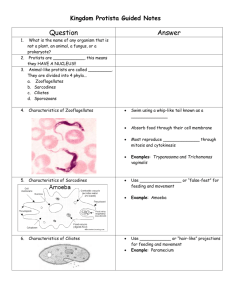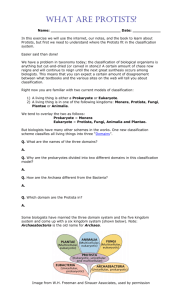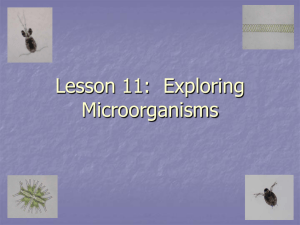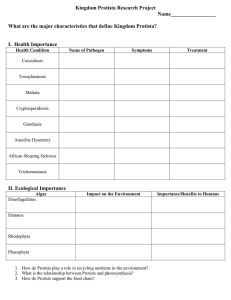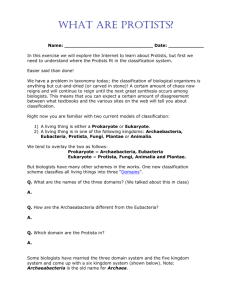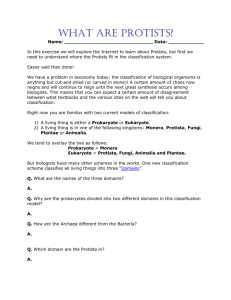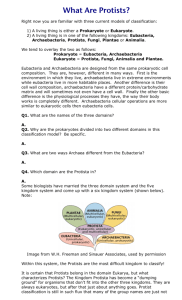Protist Classification Worksheet: Domains, Types, and Characteristics
advertisement
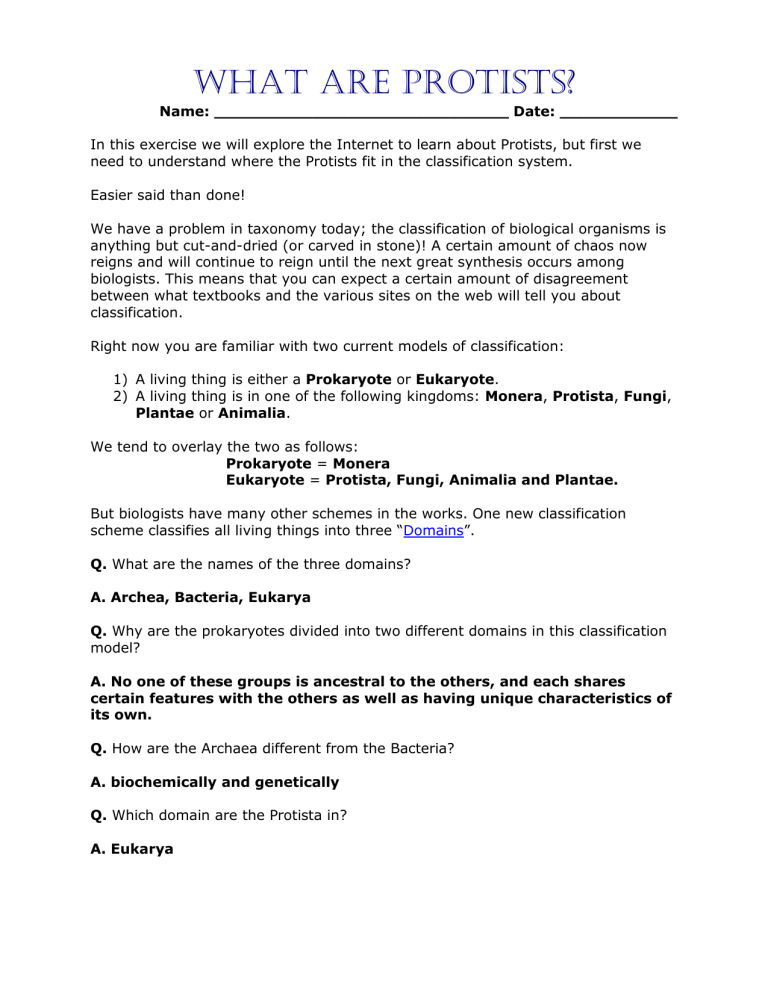
What Are Protists? Name: ______________________________ Date: ____________ In this exercise we will explore the Internet to learn about Protists, but first we need to understand where the Protists fit in the classification system. Easier said than done! We have a problem in taxonomy today; the classification of biological organisms is anything but cut-and-dried (or carved in stone)! A certain amount of chaos now reigns and will continue to reign until the next great synthesis occurs among biologists. This means that you can expect a certain amount of disagreement between what textbooks and the various sites on the web will tell you about classification. Right now you are familiar with two current models of classification: 1) A living thing is either a Prokaryote or Eukaryote. 2) A living thing is in one of the following kingdoms: Monera, Protista, Fungi, Plantae or Animalia. We tend to overlay the two as follows: Prokaryote = Monera Eukaryote = Protista, Fungi, Animalia and Plantae. But biologists have many other schemes in the works. One new classification scheme classifies all living things into three “Domains”. Q. What are the names of the three domains? A. Archea, Bacteria, Eukarya Q. Why are the prokaryotes divided into two different domains in this classification model? A. No one of these groups is ancestral to the others, and each shares certain features with the others as well as having unique characteristics of its own. Q. How are the Archaea different from the Bacteria? A. biochemically and genetically Q. Which domain are the Protista in? A. Eukarya 2 Some biologists have married the three domain system and the five kingdom system and come up with a six kingdom system (shown below). Note: Archaeabacteria is the old name for Archaea. Image from W.H. Freeman and Sinauer Associates, used by permission Within this system, the Protists are the most difficult kingdom to classify! It is certain that Protists belong in the domain Eukarya, but what characterizes Protists? The Kingdom Protista has become a “dumping ground” for organisms that don’t fit into the other three kingdoms. They are always eukaryotes, but after that just about anything goes. Protist classification is still in such flux that many of the group names are just not worth learning. In fact, some biologists predict that it is likely the Protista will be divided into 10-12 kingdoms in the coming years! Q. What are the general characteristics of Protista? A. they are primarily microscopic and unicellular, or made up of a single cell. The cells of protists are highly organized with a nucleus and specialized cellular machinery called organelles. Even though opinions vary widely, the kingdom Protista is understood to consist of three general groups. Use the web sites below to create a concept map overview of the Protist kingdom. The following terms should be included in your concept map: https://www.ck12.org/section/types-of-protists-%3a%3aof%3a%3aeukaryotes%3a-protists-and-fungi/ Fungus-like Protists Plant-Like Protists – Algae Animal-like Protists- Protozoans Diatoms Ciliates Slime Molds Amoeboids Sporozoans Red Algae Euglenoids Flagellates Dinoflagellates Green Algae Create the concept map on notebook paper 3 Now that you have done the overview, let’s learn a little more about a few interesting Protists. First, a well-known representative of the Plant-like Protists: Euglenoids Euglena have flagella and a gullet like an animal cell. (heterotrophic injestion) Euglena have chloroplasts like a plant cell (autotrophic photosynthesis) And Euglena have been known to lose their chloroplasts, forcing them to absorb nutrients from their envronment (Heterotrophic absorbtion) Consequently, Euglenoids arguably can be classified as animal, plant and fungus! Q. Two reasons the Eugleonoids are considered to be animal-like are: A. euglena can also move using its flagella and consume food through phagocytosis Q. What are three ways Euglenoids can eat? A. photosynthesis, phagocytosis (a process to engulf food particles in a vacuole), contractile vacuole to collect and remove excess fluid from the cell Q. How do Euglenoids move? Does their flagella indicate the front end or the back end of a euglena? A. Euglena moves by whipping and turning its flagella in a way like a propeller. The beating of the flagella created two motions. One is moving euglena forward (transitional motion), and the other one is rotating the euglena body (rotational motion). Flagellum (plural: flagella) is a long whip-like structure at the front of the euglena cells. Euglena wants to move towards the light for photosynthesis! Q. How does Euglena orient itself so it can move towards the light? Explain in your own words. A. Paraflagellar body (also called photoreceptor) is a swelling structure at the base of the flagellum that is photosensitive. It is the photoreceptor that senses light. Paraflagellar body, together with an eyespot, is located close to the flagella; thus their proximity promotes light-guided directional movement. 4 Euglenoids keep their shape because of a pellicle. Q. Define pellicle. A. they have a flexible and tough pellicle that facilitates their flexible and contractible movement. The pellicle is tough enough to maintain its shape but also flexible enough to allow changes in the body shape, known as metaboly movement or euglenoid movement. Ciliates Ciliates are an example of animal-like Protists. They are covered with up to 17,000 cilia beating from 40 to 60 times a second in a coordinated fashion! Cilia are used for locomotion. https://ucmp.berkeley.edu/protista/ciliata/cili atalh.html Q. What is the difference between a macro- and a micro- nucleus? A. the micronucleus undergoes mitosis, while in most ciliates the macronucleus simply pinches apart into two Q. How do ciliates deal with osmosis and the influx of excess water? A. They need to expel this extra water, otherwise they would burst. Most ciliates also have one or more large contractile vacuoles, which collect water and expel it from the cell to maintain osmotic pressure. The contractile vacuoles have a distinctive star-shape, with each “point” of the star being a water collecting tube. Q. How do ciliates eat and excrete wastes? A. Food particles are swept into the funnel-shaped oral groove and toward the cell mouth by rows of cilia. The food particles are then engulfed by phagocytosis, forming a food vacuole. Lysosomes then fuse with the food vacuole. The digestive enzymes in the lysosomes break down the food. The food particles are then small enough to diffuse through the membrane of the food vacuole and into the cytoplasm. Anything left in the food vacuole by the time it reaches the anal pore is discharged by exocytosis. Q. What are trichocysts? A. a structure in the cortex of certain ciliate and flagellate protozoans consisting of a cavity and long, thin threads that can be ejected in response to certain stimuli. 5 Rhizopods Another Protozoan group we shall examine is called Rhizopoda or Sarcodina. A typical rhizopod is the ferocious predator Amoeba proteus. The interesting thing about Amoeba is that their cytoplasm can exist in two states: the liquid “sol” endoplasm and the semisolid “gel” ectoplasm. The two consistencies work together to help the Amoeba move and feed. So how do they move? A: Amoebas move by changing the shape of their body, forming pseudopods (temporary foot-like structures). The word pseudopod means "false foot." Q. What is a pseudopod? A. The word pseudopod means "false foot." Q. How does an Amoeba survive harsh environmental conditions? A. During adverse environmental periods many amoebas survive by encystment: the amoeba becomes circular, loses most of its water, and secretes a cyst membrane that serves as a protective covering. The Amoeba seems like a harmless little guy, but some species are downright nasty! Q. What are the symptoms of amoebic dysentery (Amebiasis)? A. loose feces (poop), stomach pain, and stomach cramping. Amebic dysentery is a severe form of amebiasis associated with stomach pain, bloody stools (poop), and fever. Sporozoans Finally, let’s take a look at a not-so-nice group of Protozoans – the Sporozoans. These parasitic organisms cannot move on their own because they do not need to! They are passed from host to host in a constant disease cycle. Q. Name two human diseases caused by Sporozoans: A. Malaria, Babesiosis, and Cyclosporiasis 6 Q. A Sporozoan has a different life cycle from the disease-causing Amoeba you saw earlier. What is the major difference in life cycles? A. the great majority of Sporozoa produce sporozoites at a given point in their life cycle; the complex life cycle that alternates between sexual and asexual stages are one of the defining characteristics of Sporozoans. Here, sexual reproduction produces zygotes that develop to form sporozoites which in turn reproduce sexually or asexually.
